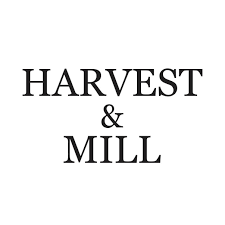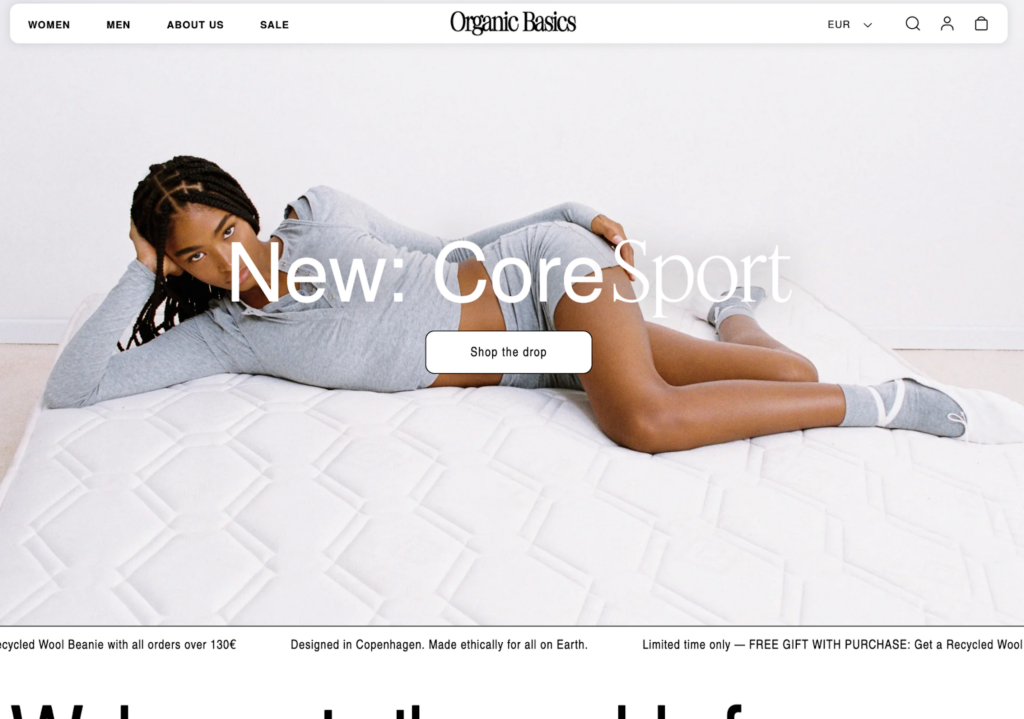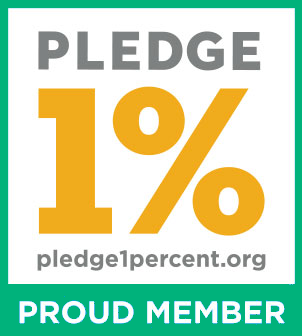10 Most Sustainable Non-Toxic Clothing Brands: The Conscious Consumer’s Guide
Affiliate Disclosure
Hey fellow impactful ninja ?
You may have noticed that Impactful Ninja is all about providing helpful information to make a positive impact on the world and society. And that we love to link back to where we found all the information for each of our posts.
Most of these links are informational-based for you to check out their primary sources with one click.
But some of these links are so-called "affiliate links" to products that we recommend.
Why do we add these product links?
First and foremost, because we believe that they add value to you. For example, when we wrote a post about the environmental impact of long showers, we came across an EPA recommendation to use WaterSense showerheads. So we linked to where you can find them. Or, for many of our posts, we also link to our favorite books on that topic so that you can get a much more holistic overview than one single blog post could provide.
And when there is an affiliate program for these products, we sign up for it. For example, as Amazon Associates, we earn from qualifying purchases.
What do these affiliate links mean for you?
First, and most importantly, we still only recommend products that we believe add value for you.
When you buy something through one of our affiliate links, we may earn a small commission - but at no additional costs to you.
And when you buy something through a link that is not an affiliate link, we won’t receive any commission but we’ll still be happy to have helped you.
What do these affiliate links mean for us?
When we find products that we believe add value to you and the seller has an affiliate program, we sign up for it.
When you buy something through one of our affiliate links, we may earn a small commission (at no extra costs to you).
And at this point in time, all money is reinvested in sharing the most helpful content with you. This includes all operating costs for running this site and the content creation itself.
What does this mean for me personally?
You may have noticed by the way Impactful Ninja is operated that money is not the driving factor behind it. It is a passion project of mine and I love to share helpful information with you to make a positive impact on the world and society. However, it's a project in that I invest a lot of time and also quite some money.
Eventually, my dream is to one day turn this passion project into my full-time job and provide even more helpful information. But that's still a long time to go.
Stay impactful,
Amid growing concerns about harmful synthetic chemicals used in the textile industry, there is a need to find safe clothes for your wardrobe. Organic fabrics are becoming quite the preferred textile materials as organic cultivation doesn’t depend on synthetic agrochemicals. But is there anything else brands can do to make their clothes more gentle to consumers’ health and the environment? So, we had to ask: Which are the most sustainable non-toxic clothing brands?
The most sustainable non-toxic clothing brands are MATE the Label, PAKA, and Harvest & Mill, which use clean materials, employ full traceability, and maintain a relatively short supply chain. In addition, Pact and Organic Basics commit to using organic fabrics while reducing their carbon footprint.
Whether you are searching for a sweater, a pair of yoga pants, or some comfortable underwear to add to your wardrobe without worrying about harmful chemicals, there is a brand for you. So, let’s keep reading to learn more about the most sustainable non-toxic clothing brands and how they ensure sustainable, ethical practices.
Here’s How We Selected the 10 Most Sustainable Non-Toxic Clothing Brands
Toxic synthetic chemicals can be used throughout the fashion supply chain, from sourcing fibers to dyeing fabrics to packaging. Such chemicals have high environmental impacts and could be harmful to your skin.
“Sustainable: The ability to be maintained at a certain rate or level | Avoidance of the depletion of natural resources in order to maintain an ecological balance”
Oxford Dictionary
The brands on this list were chosen based on their commitment and actions to promote sustainable practices while reducing the environmental impacts of the textile industry.
They are transparent about their materials, processes, and workforce management within their supply chain.
Some brands focus their efforts on reducing waste and optimizing natural resources while others strive to reduce the carbon footprint of their clothes.
All of these brands share the commitment to reshape the textile industry toward a more sustainable and Earth-friendly sector.
These Are the 10 Most Sustainable Non-Toxic Clothing Brands
Most Sustainable Non-Toxic Clothing Brands
Overall, these non-toxic clothing brands are sustainable. Yet, they take various approaches to reduce environmental impacts and uphold ethical standards. Let’s dive into each brand and find out more.
MATE the Label: Clean From Seed to Skin


“To provide people everywhere with essentials that are clean from seed to skin.”
MATE the Label
🌎
How do they ensure their sustainability?
MATE the Label ensures sustainability by sourcing low-impact natural materials, reducing carbon footprints, and recycling.
- They opt for plant-based yarns (organic cotton, linen, TENCEL™ Lyocell) and non-toxic dyes. At least 50% of their clothing items are made with organic or recycled plant fibers.
- Furthermore, they manufacture locally (within 15 miles of their office) to reduce transportation emissions. The brand also diverts their textile waste (pre- and post-consumer) into making new products.
- Lastly, they have B Corporation and Climate Neutral certifications.
🌐
How do they ensure their ethics?
MATE the Label has a Code of Conduct covering four of the ILO’s Fundamental Principles and Rights at Work.
- Specifically, they do final production in US factories where they had banned, since day 1, the piece rate pay—a practice that often leads to wages below minimum wage and unsafe working conditions.
- They commit to creating safe, comfortable, and fair working environments for everyone in their supply chain, including farmers, garment workers, and recyclers.
- They also make regular visits to their suppliers.
🤝
Are they part of any giving-back programs?
In 2021, MATE the Label donated 1% of sales to nonprofit partners that are committed to saving the planet. On Giving Tuesday in 2021, they upped the donation from 1% of every purchase to 5%. Since their partnership with BEAM Impact, MATE the Label’s customers have been able to choose which organization the donations of their order should go to.
🛍️
What is their product range?
- Best for: minimalistic, versatile clothes for women
- Product range: sweaters, dresses, pants, hoodies, maternity wear, blouses, T-shirts, jumpsuits, underwear
- Price range: $$
- Size range: XS–XL
Paka: Non-Toxic Outdoor Clothing Made With Traceable Alpaca Wool


“Paka was created to bring you closer to where your clothing comes from, what it’s made of, and who made it.”
Paka
🌎
How do they ensure their sustainability?
Paka prioritizes sustainability by innovating and making low-impact, high-performing fabrics with ethical alpaca wool.
- In particular, they source alpaca wool from small-scale, family-owned herds. Each herd contains 60 to 90 animals roaming free throughout the Peruvian Andean Highlands. After the fleece is shorn, the fiber is collected and separated by hand before being colored (if needed) with environmentally friendly dyes certified by OEKO-TEX® and GOTS. Half of the energy used in their alpaca wool spinning process comes from solar energy.
- Further down the life-cycle in the transporting stage, Paka alpaca products are delivered carbon-neutral through their partnership with Ecocart. The packaging is also fully biodegradable.
🌐
How do they ensure their ethics?
Paka ensures their ethics by making their alpaca wool products fully traceable, from free-roaming alpacas up in the Andes Mountains to customers’ homes in the US.
- The 100+ Quechua women weavers who make Paka’s products are employed by the brand and paid 4 times the family living wage.
- Regarding alpaca treatment, Paka uses a special technique (Inca Esquila) to minimize the time and stress posed upon the animal during the shearing process.
🤝
Are they part of any giving-back programs?
Through their partnership with Peruvian Hearts, Paka supports the education of underprivileged Peruvian young women with 1% of their annual revenues. Another 1% of their sales supports regenerative agriculture and alpaca families. Additionally, they provide free weaving training for women who want to learn a skill, as well as a “Wawa Wasi” (daycare) in the neighborhood, with full-time supervision and a trained psychologist to enable mothers to go to work. Lastly, Paka is helping to build an NGO that preserves the Inca traditions.
🛍️
What is their product range?
- Best for: women’s and men’s knitwear
- Product range: jackets, sweaters, hoodies, baselayer, T-shirts, joggers, socks, underwear, accessories
- Price range: $$$
- Size range: XXS–XXL
Harvest & Mill: Carbon-Neutral Apparel Made in Organic and Traceable US-Based Supply Chain


“We use zero fabric wholesalers or brokers and we use only 100% USA grown organic cotton yarns – because that is the only way to have true transparency in fashion and fabric chemical content.”
Harvest & Mill
🌎
How do they ensure their sustainability?
Harvest & Mill’s sustainability efforts focus on using low-impact materials, minimizing textile waste, and achieving carbon neutrality.
- Firstly, they source eco-friendly materials, from fibers to dyestuff to packaging. In particular, they source a high proportion of organic cotton, grown and milled in the US, for their socks, bottoms, and tops. They also opt for low-impact, natural, and non-toxic dyestuff for some of their apparel while eliminating dyes altogether for their sock collection, their Organic Heirloom Brown Collection, and all their natural-white joggers and tops.
- Regarding packaging and shipping, Harvest & Mill uses plastic-free, reusable, recyclable, and easily compostable materials. Secondly, they minimize textile waste by designing patterns that reduce off-cuts while repurposing or recycling all extra fabrics.
- Thirdly, they achieve carbon neutrality by reducing and offsetting their emissions. Beyond that, they hold their supply chain entirely in the US, shortening the transporting distances (by five times).
- And lastly, they offset all their carbon emissions, including production, supply chain transportation, office operation, and all orders they ship out.
🌐
How do they ensure their ethics?
Harvest & Mill traces their whole supply chain and visits their suppliers regularly. They state that from the farm workers to the factory workers, everyone who works on Harvest & Mill clothing receives a fair wage, safe working conditions, the legally protected right to organize, and protection from discrimination.
🤝
Are they part of any giving-back programs?
Harvest & Mill is a member of Fibershed, a nonprofit that develops regional fiber systems that build soil and protect the health of Earth’s biosystems.
🛍️
What is their product range?
- Best for: womenswear, menswear
- Product range: shirts, T-shirts, pants, shorts, socks
- Price range: $$$
- Size range: S–XL
Pact: Non-Toxic Essential Clothing Made Ethically and Sustainably


“We believe the planet, and the people on it, should always come first in fashion.”
Pact
🌎
How do they ensure their sustainability?
Pact ensures sustainability by using low-impact textile and packaging materials, offsetting the carbon impact of all their products, and facilitating the donation of used clothes to reduce waste.
- They use a high proportion of eco-friendly fabrics, including organic fabrics made with GOTS-certified cotton.
- Additionally, their clothes are delivered in VelaTM paper bags. These bags are made with carbon-neutral, FSC-certified, recyclable paper.
- Pact also partners up with SimpliZero. This partnership enables measuring the impact of every product Pact makes and offsetting it through reforestation, renewable energy, and community projects sequestering carbon from the atmosphere.
- Their Give Back Box incentive enables their customers to reuse the boxes their Pact orders came in and donate their used clothes to local charities with the postal fee paid for by Pact.
🌐
How do they ensure their ethics?
Pact uses Fair Trade CertifiedTM factories, providing safe working conditions, community support, and additional development funds to workers in their supply chain. They also trace most of their supply chain, including the final stage of production.
🤝
Are they part of any giving-back programs?
Pact is not known to be part of any giving-back programs.
🛍️
What is their product range?
- Best for: womenswear, menswear
- Product range: dresses, hoodies, sweatshirts, activewear, sleepwear, maternity wear, T-shirts, underwear, jumpsuits, playsuits, plus-size
- Price range: $$$
- Size range: XS–XXXL
Organic Basics: A Carbon Neutral Brand Creating Non-Toxic Underwear, Activewear, and Everyday Essentials


“We make our basics to be both Earth- and people-friendly — carefully choosing materials and fabrics that care for our environment, only partnering with factories that consider their impact too, and designing all the basics for all bodies.”
Organic Basics
🌎
How do they ensure their sustainability?
Organic Basics promotes sustainability by choosing fabrics based on their environmental footprint and lifetime durability.
- Their clothes are made organic fabrics (cotton certified by the Global Organic Textile Standard), low-impact textiles (TENCEL™ lyocell certified by the STANDARD 100 by OEKO-TEX®), or recycled materials (recycled wool, recycled cotton, and recycled nylon). They use a small percentage of elastane (spandex) in some garments to extend the products’ longevity, which ultimately extends the lifespan.
- Organic Basics is fully transparent about the impact of their products, enabling consumers to understand their share in using the clothes. Organic Basics partners with Made2Flow, which calculates their emissions, and One Carbon World, which helps them reduce and offset all their emissions.
- Finally, they are also a B Corporation.
🌐
How do they ensure their ethics?
Organic Basics works only with trusted, certified factory partners, who ensure that their workplace is free of child labor and forced labor and that their workers enjoy a safe working space, earn a living wage, and benefit from employee perks like free lunches and childcare.
- They show full transparency of the location and practices in their factories.
- Organic Basics also audits or visits most of their suppliers.
🤝
Are they part of any giving-back programs?
Organic Basics donates 1% of the value of all orders to sustainable projects. Their partnership with Beam Impact enables consumers to choose where their 1% donation will go, at no extra cost to the consumers, to support local charities that help Nature Conservation, Ocean Conservation, Rewilding, or Sustainability & Gender Equity.
🛍️
What is their product range?
- Best for: womenswear, menswear
- Product range: underwear, bras, bottoms, T-shirts, tops, sweatshirts, hoodies, knitwear dresses, swimwear, socks, plus-size
- Price range: $$$
- Size range: XXS–XXL
Sustain by Kat: Organic Clothing Free of Synthetic Dyes


“Sustain’s goal is to make clothing that is more than just low impact. We create clothing that actually has a positive impact on our world, helping both the environment and the people in it.”
Sustain by KAT
🌎
How do they ensure their sustainability?
Sustain by Kat prioritizes sustainability by sourcing plant-based fibers and dyes to eliminate harmful chemicals and help remove carbon from the atmosphere.
- Firstly, they use a high proportion of low-impact plant fibers, including organic cotton and linen. Further down the life-cycle in the manufacturing stage, Sustain by Kat opts for using exclusively natural dyes made from various plant materials, such as pomegranate peels, oak galls, rhubarb, myrobalan fruits, madder root, fustic wood, logwood, and indigo leaves.
- The brand also offers apparel completely free of dyes, chemical bleaches, optical brighteners, and synthetic softeners.
- Lastly, all their packaging is made from 100% recycled materials and is fully recyclable. They ship orders using 100% recycled poly mailers (which include 50% post-consumer waste) with a reusable tear strip for reuse and easy returns or exchanges. Their shipping labels and internal packaging, including invoices, wrapping, and even their stickers, are made from 100% recycled paper using post-consumer waste.
🌐
How do they ensure their ethics?
Sustain by Kat traces most of their supply chain. They state that they provide fair wages and safe working conditions to support small, marginalized communities in India where their Ayurvedic collection is produced. The rest of their apparel is made locally in the US.
🤝
Are they part of any giving-back programs?
Sustain by Kat is not known to be part of any giving-back programs.
🛍️
What is their product range?
- Best for: womenswear, kidswear
- Product range: tanks, tees, shirts, blouses, shorts, pants, underwear, bras, accessories underwear
- Price range: $$
- Size range: XS–XL
HARA the Label: Garments Designed Collectively for You and Our Earth


“We stand for slow fashion, transparent supply chains and an ethical production line you can be proud to support.”
HARA the Label
🌎
How do they ensure their sustainability?
HARA the Label promotes sustainability by using mostly low-impact organic bamboo lyocell fabrics for garments.
- They source only bamboo grown without synthetic pesticides, insecticides, and fertilizers from suppliers with an OEKO-TEX® STANDARD 100 certification. Further down the life-cycle in the manufacturing stage, their bamboo lyocell fabrics are produced in a closed-loop system that filters and reuses all the water and solvent.
- Additionally, all their clothing items are colored with low-impact, non-toxic dyes. Specifically, they use natural dyes derived from plants like turmeric, indigo, and madder root, as well as GOTS-certified fiber-reactive dyes, which require relatively low water.
- Lastly, HARA the Label produces clothes locally in Australia to reduce transport carbon footprint.
🌐
How do they ensure their ethics?
HARA the Label traces most of their supply chain, including the final stage of production in Australia.
🤝
Are they part of any giving-back programs?
HARA the Label is not known to be part of any giving-back programs.
🛍️
What is their product range?
- Best for: womenswear
- Product range: underwear, loungewear, loungewear, plus-size
- Price range: $$$
- Size range: XS–5XL
Colorful Standard: Non-Toxic Apparel Made With Organic and Recycled Materials


“Our brand centers around the fact that we don’t care much for seasons or trends, instead, we create timeless and long-lasting products to avoid the downward spiral that is over-consumption.”
Colorful Standard
🌎
How do they ensure their sustainability?
Colorful Standard ensures their sustainability by sourcing low-impact materials, minimizing waste, and striving to extend the product lifespan.
- Firstly, they source 100% eco-friendly textile materials, specifically organic cotton and GRS-certified recycled merino wool, saving water and energy while avoiding harmful chemicals. Also, all the dyes they use to develop their various shades are certified by OEKO-TEX® as being thoroughly tested for harmful chemicals. Colorful Standard further ensures that all labels and boxes come from recycled plastics and FSC-certified paper.
- Secondly, their waste reduction approaches include garment dyeing instead of piece dyeing to save water, precise laser cutting to keep fabric waste to a bare minimum, and utilizing fabric scraps as furniture filling.
- Lastly, they design timeless essentials that withstand the test of time by using high-quality materials and advising on proper garment care.
🌐
How do they ensure their ethics?
Colorful Standard traces most of their supply chain. Their final production stage happens in Portugal, a medium-risk country for labor abuse. They also manufacture in-house at their own manufacturing center, RTG Textiles, to ensure ethics in the supply chain. On top of that, they state that they work under the European Labour Law, which ensures that all employees at their manufacturing center work fair hours for fair wages.
🤝
Are they part of any giving-back programs?
Colorful Standard is not known to be part of any giving-back programs.
🛍️
What is their product range?
- Best for: menswear, womenswear
- Product range: hoodies, sweatshirts, T-shirts, shirts, tank tops, pants, shorts, underwear, activewear, socks, accessories
- Price range: $$
- Size range: XS–2XL
Kotn: Quality Essential Designed in Canada and Made Ethically in Egypt


“A world of timeless designs that honour the people who make them and the places they’re made.”
Kotn
🌎
How do they ensure their sustainability?
Kotn ensures their sustainability by sourcing some eco-friendly materials and minimizing textile waste.
- Firstly, they focus on natural fibers, which can biodegrade at the end of their life-cycle, including cotton, linen, and merino wool. Their cotton stock, in particular, comprises GOTS-certified organic cotton, Better Cotton Initiative cotton, and ECOTEC recycled cotton. Kotn also sources TENCELTM Lyocell, a biodegradable regenerated fiber made in a closed-loop manufacturing system. Further down the life-cycle in the manufacturing stage, Kotn colors their fabrics using OEKO-TEX® certified non-toxic dyes. The brand is also committed to using environmentally safe materials to transport all their pieces from their first to their final step. These include a recycled and recyclable cardboard mailer and a complimentary sustainably crafted tote.
- Secondly, the brand reduces textile waste by utilizing low-waste cutting methods and upcycling leftover materials.
🌐
How do they ensure their ethics?
Kotn ensures their ethics by working directly with responsibly run facilities to ensure fair wages and treatment throughout their supply chain, better prices for their customers, and 100% traceability from farm to hanger.
🤝
Are they part of any giving-back programs?
Kotn donates a portion of their annual proceeds to fund and build primary schools in the Nile Delta and Faiyum, Egypt, investing in their farming communities’ long-term economic growth. So far, they have funded 21 schools.
🛍️
What is their product range?
- Best for: womenswear, menswear
- Product range: T-shirts, tanks, tops, bottoms, dresses, suits, socks, accessories knitwear
- Price range: $$
- Size range: XXS–XXL
The Standard Stitch: Non-Toxic and Sustainable Made Clothing


“We’re setting the bar higher by rethinking the way clothes are made at every step of the process. We believe that cleaner, more thoughtful practices can change the way fashion impacts people and the planet.”
The Standard Stitch
🌎
How do they ensure their sustainability?
The Standard Stitch ensures their sustainability by sourcing a high proportion of low-impact materials and reducing their water use and carbon emissions.
- Firstly, they blend cotton fabric scraps from cutting waste with certified organic cotton to make their fabrics, reducing textile waste and, at the same time, increasing the demand for more sustainable agriculture practices in the industry. Additionally, all the trims—labels, swing tags, and drawcords—are made with only certified recycled or organic materials. These components are printed with eco-friendly inks, which are fully biodegradable and recyclable. The Standard Stitch is also environmentally conscious about their packaging, using recyclable and biodegradable kraft mailers with 100% recycled content. Their poly bags are either compostable or recycled.
- Secondly, further down the life-cycle in the manufacturing stage, the brand opts for non-toxic and low-impact dyes, requiring less rinsing water.
- Thirdly, they reduce their carbon emissions by operating through a localized supply chain based in Los Angeles, only miles from their main office, and avoiding expedited shipping, which has a high carbon footprint. They also offset their emissions in the Medford Spring Grassland Conservation Project. Striving toward closing the loop, The Standard Stitch has set up the Re-Stitch x Retold program, which takes back pre-loved items to be recycled into new materials.
🌐
How do they ensure their ethics?
The Standard Stitch has 100% traceability into their Tier 1 and Tier 2 suppliers and has mapped out 50% of Tier 3. Their Vendor Code of Ethics covers all of the ILO’s Fundamental Principles and Rights at Work.
🤝
Are they part of any giving-back programs?
The Standard Stitch is not known to be part of any giving-back programs.
🛍️
What is their product range?
- Best for: womenswear
- Product range: dresses, shorts, sweatshirts, T-shirts, tanks, sweatpants, joggers,
- Price range: $$$
- Size range: XS–5XL
Why Is It Important to Buy Products Made of More Sustainable Fabrics
It is important to buy products made of more sustainable fabrics because a sustainable textile industry has a lower carbon footprint, helps save natural resources, and is ultimately better for forests, animals, and humans.
Buying Sustainable Fabrics Reduces Your Carbon Footprint
The production of clothing and footwear is estimated to contribute 10% of global greenhouse gas emissions—more than all international flights and shipping combined. If the fashion industry were a country, it would be the fourth largest emitter of carbon dioxide.
One way to reduce the carbon footprint of the clothes you buy is to opt for sustainable fabrics. Sustainable fabrics, which are often made with natural or recycled fibers, have relatively low carbon footprints compared to petroleum-based fabrics. For example, organic fabrics made in the US have a carbon footprint of 2.35 kg CO2 (per ton of spun fiber)—a quarter of polyester’s carbon footprint.
Buying Sustainable Fabrics Reduces Demand for Natural Resources and Waste Management
The textile industry uses water and land to grow cotton and other fibers. It is estimated that 79 billion cubic meters of water were used for the sector worldwide in 2015. For example, producing a single cotton T-shirt requires as much water as one person drinks for 2.5 years (2,700 liters of fresh water).
Worse yet, the textile economy is vastly more linear than circular: the largest amount of resources used in clothes ended up in landfills (instead of being recycled to remake clothes). According to a report by the Ellen MacArthur Foundation,
- Less than 3% of materials used in the textile economy in 2015 came from recycled sources.
- In other words, more than 97% of resources used in making clothes are newly extracted.
When clothing items are disposed of within a short period of time—under a year in the case of half of the fast fashion clothes—the natural systems that provide raw materials for fabrics don’t have enough time to recover and regenerate, which could lead to ecological breakdown.
Sustainable fabrics are made with less water and emissions while lasting longer:
- Because they are durable, you don’t need to buy new clothes too often.
- Thus, you help reduce the pressure to extract more resources for making new items.
Similarly, making and consuming sustainable fabrics made with recycled materials reduces the demand for virgin materials while helping tackle waste management.
Buying Sustainable Fabrics Encourages Sustainable Management of Forests
Sustainable plant-based fabrics are made with raw materials from forests and plantations that are sustainably managed, such as by complying with FSC standards.
When you buy sustainable plant-based fabrics, you discourage unsustainable forestry practices like illegal logging. By doing this, you can also help reduce deforestation, biodiversity loss, and the effects of climate change.
Buying Sustainable Fabrics Encourages Fairer Treatment of Animals
The fashion industry is rife with animal mistreatment when it comes to making animal-based fabrics like wool or silk. Every year, billions of animals suffer and die for clothing and accessories.
Buying sustainable vegan alternatives can help to reduce the pressure on raising more and more animals to meet the demand for animal-based fabrics while sacrificing their well-being and lives.
Suppose you have to buy fabrics made with, for example, wool or silk. In this case, make sure you only choose brands committed to cruelty-free products. In doing so, you help advocate better treatments for animals raised within the textile industry.
Using Sustainable Fabrics Encourages Fairer Treatment of Textile Workers
Recent statistics from UNICEF estimated as many as 170 million child laborers worldwide, many of whom were engaged in some form of work in the textile industry. They don’t get paid minimum wages and often work long hours.
When you buy sustainable fabrics from brands transparent about the working conditions at their factories, you discourage the use of child labor and help promote better working conditions for textile workers.
How Can You Generally Buy More Sustainable Fabrics
The key to sustainably buying fabrics is to check on relevant environmental and original certifications.
For natural fabrics:
- Global Organic Textile Standard (GOTS): A globally recognized certification system that ensures a certain threshold of organic content has been met. It covers manufacturing, packaging, labeling, transportation, and distribution (but not what happens in the fields where crops are grown).
- USDA Certified Biobased Product: The USDA BioPreferred® Certification is a voluntary certification offered by the United States Department of Agriculture. The certification identifies products made from plants or other renewable materials.
- Ecolabel: Ecolabel is the official European Union voluntary label recognized worldwide for certified products with a guaranteed, independently verified low environmental impact. The label requires high environmental standards throughout the entire life-cycle: from raw material extraction through production and distribution to disposal. It also encourages companies to develop innovative, durable, easy-to-repair, and recyclable products.
For plant-based semi-natural/semi-synthetic fabrics:
- Forest Stewardship Council: An FSC certification ensures that the wood (or wood-like material) comes from responsibly managed forests that provide environmental, social, and economic benefits.
There are two types of FSC Certification:- FSC Forest Management Certification, with a focus on the origin of the wood—the forest.
- FSC Chain of Custody Certification, which focuses on the path from the forest to the customer’s home.
- Program for Endorsement of Forest Certification: PEFC’s approaches to sustainable forest management are in line with protecting the forests globally and locally and making the certificate work for everyone. Getting a PEFC certification is strict enough to ensure the sustainable management of a forest is socially just, ecologically sound, and economically viable but attainable not only by big but also small forest owners.
For recycled fabrics:
- Recycled Claim Standard (RCS): The Textile Exchange RCS was originally developed as an international, voluntary standard that sets requirements for third-party certification of Recycled input and chain of custody.
- The Global Recycled Standard (GRS): The Global Recycled Standard (GRS) is an international, voluntary, full product standard that sets requirements for third-party certification of Recycled Content, chain of custody, social and environmental practices, and chemical restrictions. It can be used for any product with more than 20% recycled material.
For all types of fabrics:
- STeP by OEKO-TEX®: STeP by OEKO-TEX® is an independent certification system for brands, retailers, and manufacturers from the textile and leather industry. It communicates organizational environmental measures, including reducing carbon footprint and water usage.
- OEKO-TEX® Standard 100: OEKO-TEX® labels aim to ensure that products pose no risk to human health (i.e. containing banned chemicals).
Some certifications that are signaling brands’ efforts toward lowered environmental impacts and a circular economy are:
- B Corp Certification: The label B Corp is a certification reserved for for-profit companies. Certified holders are assessed on their social and environmental impacts.
- Cradle2Cradle certification: Cradle2Cradle provides a standardized approach to material circularity. It assesses whether products have been suitably designed and made with the circular economy in mind covering five critical categories: material health, material reuse, renewable energy and carbon management, water stewardship, and social fairness.
Final Thoughts
Non-toxic clothing brands eliminate the use of harmful synthetic chemicals in sourcing, manufacturing, and transporting, reducing their negative impact on both the environment and the health of consumers and textile workers.
By purchasing new or pre-loved clothes from non-toxic clothing brands that commit to sustainability, you support their mission to create a fairer and less harmful textile industry for all lives on Earth.
Here is the list (again) of the most sustainable non-toxic clothing brands:
- MATE the Label
- Paka
- Harvest & Mill
- Pact
- Organic Basics
- Sustain by Kat
- HARA the Label
- Colorful Standard
- Kotn
- The Standard Stitch
To make your use of these non-toxic clothes even more sustainable, follow these steps:
- Buy second-hand, recycled, or upcycled clothes.
- While using non-toxic clothes, maximize the number of wears between washes and keep them as long as possible.
- At the end-of-life of your non-toxic clothes, upcycle the materials to extend their usage and arrange for them to be recycled or properly disposed of.
Stay impactful,

Sources
- MATE the Label: Home
- PAKA: Home
- Harvest & Mill: Home
- Pact: Home
- Organic Basics: Home
- Sustain by Kat: Home
- HARA the Label: Home
- Colorful Standard: Home
- Kotn: Home
- The Standard Stitch: Home
- Good On You: Brand Directory | MATE the Label
- Impactful Ninja: How Sustainable Are Organic Cotton Fabrics? A Life-Cycle Analysis
- Impactful Ninja: How Sustainable Are Linen Fabrics? A Life-Cycle Analysis
- TENCEL: TENCELTM Lyocell
- MATE the Label: Dress Clean
- B Corporation: MATE the Label
- CLIMATE NEUTRAL: MATE the Label
- International Labor Organization (ILO): Fundamental Principles and Rights at Work
- MATE the Label: 2021 Impact Report
- B Corporation: Paka
- Impactful Ninja: How Sustainable Are Alpaca Wool Fabrics? A Life-Cycle Analysis
- Paka: Alpaca Wool
- Paka: Traceable Alpaca Fiber
- OEKO TEX: Home
- Global Organic Textile Standard (GOTS): Home
- Paka: Earth
- Peruvian Hearts: Home
- Paka: Empowerment
- Good On You: Brand Directory | Harvest & Mill
- Impactful Ninja: How Sustainable Are Organic Cotton Fabrics? A Life-Cycle Analysis
- Harvest & Mill: Sustainability
- Harvest & Mill: Organic Heirloom Brown Collection
- Fibershed: Harvest & Mill
- Good On You: Brand Directory | Pact
- Impactful Ninja: How Sustainable Are Organic Fabrics? A Life-Cycle Analysis
- Global Organic Textile Standard (GOTS): Home
- Impactful Ninja: How Sustainable Are Cotton Fabrics? A Life-Cycle Analysis
- VelaTM paper bags: Home
- Pact: Responsible Packaging
- SimpliZero: Home
- Pact: Sustainability, Certified
- Pact: Give Back Box
- Organic Basics: FAQ
- Impactful Ninja: How Sustainable Are Organic Fabrics? A Life-Cycle Analysis
- Global Organic Textile Standard (GOTS): Home
- Impactful Ninja: How Sustainable Are TENCEL™ Fabrics? A Life-Cycle Analysis
- OEKO-TEX: STANDARD 100 by OEKO-TEX®
- Impactful Ninja: How Sustainable Are Recycled Wool Fabrics? A Life-Cycle Analysis
- Impactful Ninja: How Sustainable Are Recycled Cotton Fabrics? A Life-Cycle Analysis
- Impactful Ninja: How Sustainable Are Recycled Nylon Fabrics? A Life-Cycle Analysis
- Impactful Ninja: How Sustainable Are Elastane Fabrics? A Life-Cycle Analysis
- Impactful Ninja: How Sustainable Are Spandex Fabrics? A Life-Cycle Analysis
- Made2Flow: Home
- One Carbon World: Home
- B Corporation: Organic Basics
- Organic Basics: Factories
- Good On You: Brand Directory | Organic Basics
- Organic Basics: Our Impact
- Beam Impact: Home
- Good On You: Brand Directory | Sustain by Kat
- Sustain by Kat: Completely Natural, Down to the Thread
- Impactful Ninja: How Sustainable Are Organic Cotton Fabrics? A Life-Cycle Analysis
- Impactful Ninja: How Sustainable Are Linen Fabrics? A Life-Cycle Analysis
- Sustain by Kat: Sensitive Skin
- Sustain by Kat: Shipping
- Sustain by Kat: More than Sustainable
- Impactful Ninja: How Sustainable Are Bamboo Lyocell Fabrics? A Life-Cycle Analysis
- HARA The Label: Bamboo Fabric
- OEKO-TEX: OEKO-TEX® STANDARD 100
- Good On You: Brand Directory | HARA the Label
- HARA the Label: Natural dyes
- Colorful Standard: Men’s Organic Hoodies
- Colorful Standard: Women’s Organic Hoodies
- Impactful Ninja: How Sustainable Are Organic Cotton Fabrics? A Life-Cycle Analysis
- Textile Exchange: Global Recycle Standard
- Impactful Ninja: How Sustainable Are Merino Wool? A Life-Cycle Analysis
- Colorful Standard: Sustainable Materials
- OEKO-TEX: Home
- Colorful Standard: Environmentally friendly dyes
- Colorful Standard: Zero Waste
- Colorful Standard: No season and long-lasting
- Good On You: Brand Directory | Colorful Standard
- Colorful Standard: Transparency
- Colorful Standard: Ethical labor practices
- B Corporation: Kotn
- Kotn: For Lasting Ways of Life
- Kotn: Our Materials
- Impactful Ninja: How Sustainable Are Cotton Fabrics? A Life-Cycle Analysis
- Impactful Ninja: How Sustainable Are Linen Fabrics? A Life-Cycle Analysis
- Impactful Ninja: How Sustainable Are Merino Wool Fabrics? A Life-Cycle Analysis
- Global Organic Textile Standard: Home
- Impactful Ninja: How Sustainable Are Organic Cotton Fabrics? A Life-Cycle Analysis
- Better Cotton: Home
- Marchi & Fildi: ECOTEC
- Impactful Ninja: How Sustainable Are TENCELTM Fabrics? A Life-Cycle Analysis
- Kotn: Our Supply Chain
- Kotn: Our Schools
- Good On You: Brand Directory | The Standard Stitch
- The Standard Stitch: SUSTAINABILITY
- Native: Medford Spring Grassland Conservation Project
- The Standard Stitch: Re-Stitch x Retold
- The Standard Stitch: Vendor Code of Ethics
- International Labour Organization: ILO’s Declaration on Fundamental Principles and Rights at Work
- European Parliament: The impact of textile production and waste on the environment (infographic)
- Science Direct: The challenge of “Depeche Mode” in the fashion industryDoes the industry have the capacity to become sustainable through circular economic principles, a scoping review
- Science Direct: Carbon Footprint of Textile and Clothing Products
- European Parliament: Environmental impact of the textile and clothing industry
- European Parliament: What if fashion were good for the planet?
- Ellen MacArthur Foundation: A New Textiles Economy: Redesigning fashion’s future
- McKinsey: Style that’s sustainable: A new fast-fashion formula
- Forest Stewardship Council: Home
- Our World in Data: Deforestation and Forest Loss
- Our World in Data: Renewable Energy
- Peta: Animals Used For Clothing
- The Guardian: Child labour in the fashion supply chain
- Impactful Ninja: How Sustainable Are Natural Fabrics? A Life-Cycle Analysis
- Global Organic Textile Standard (GOTS): Home
- BioPreferred: WHAT IS THE BIOPREFERRED PROGRAM?
- European Commission: Environment | EU Ecolabel
- Impactful Ninja: How Sustainable Are Semi-Natural/Semi-Synthetic Fabrics? A Life-Cycle Analysis
- Forest Stewardship Council
- FSC Forest Management Certification
- FSC Chain of Custody Certification
- Textile Exchange: The RCS and GRS are designed to boost the use of recycled materials
- Program for Endorsement of Forest Certification
- Impactful Ninja: How Sustainable Are Recycled Fabrics? A Life-Cycle Analysis
- Textile Exchange: Recycled Claim Standard
- Textile Exchange: Global Recycled Standard
- OEKO-TEX: Certification according to STeP by OEKO-TEX
- OEKO-TEX: STANDARD 100 by OEKO-TEX®
- B Corp Certification: Home
- C2CCertified: Home







